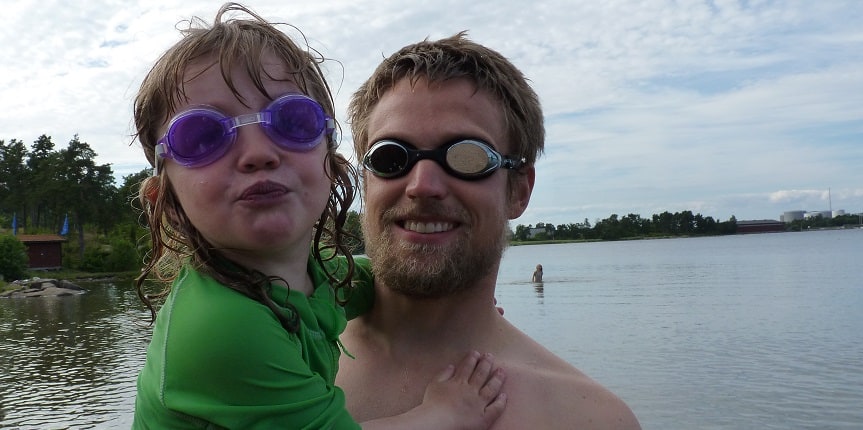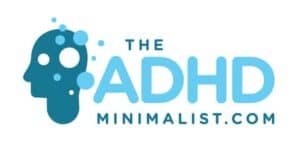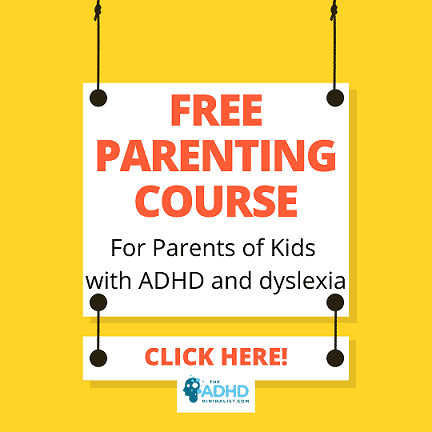
Noticing the early signs of ADHD is not always easy, especially when the symptoms aren’t blatantly obvious!
I am the mother of three kids two of which have ADHD. It was much easier to see the hyperactive symptoms my son was notorious for than the ADHD predominately inattentive symptoms my daughter was exhibiting.
Growing up in the United States I had my fair share of problems in school. As an adult, I wonder if some of these difficulties could be contributed to ADHD.
I grew up in a time when ADHD was not as common or as well understood as it is now, and unless children had extreme symptoms often no one thought of ADHD as a possibility.
Parents (myself included) often try to dismiss worrying behavior in young children. No one wants their child to have a diagnosis. It’s easy to hope your child will grow out of a ‘Phase’ instead of looking closely at what the facts are telling you. This can contribute to many girls being overlooked for an ADHD diagnosis. They often don’t have blatantly obvious symptoms as many boys do.
Taking a closer look at the first symptoms my husband and I noticed in our kids may help you to face the facts head-on and not stick your head in the sand hoping your kids will grow out of a ‘Phase’ as we did in the beginning!
Annie eklöv

I believe that boys with ADHD inattentive symptoms can be harder to diagnose than boys with ADHD predominately hyper just like girls seem to be harder to diagnose than boys, and girls with ADHD predominately inattentive seem to be the hardest of all to spot at an early age.
Some friends of ours have a son who was diagnosed with ADHD predominately inattentive a couple of years ago. They caught the symptoms when he was eleven. Our son was diagnosed around the age of 8 with ADHD (hyper) although we started the process of getting a diagnosis long before that. In Sweden, it’s a much more thorough process for getting a diagnosis than in the United States!
According to the Swedish ADHD-Center in Stockholm, early research on ADHD was mainly focused on boys and men because the pervading thought among professionals and researchers was that girls could not have ADHD!
https://docplayer.se/4325867-Flickor-med-adhd-anna-hogfeldt-leg-psykolog-adhd-center-2013-08-22.html
Undiagnosed Girls were deemed to be a risk
Girls with ADHD have been noted to have significantly lower self-esteem compared to their peers and are at risk for alarming behaviors such as cutting/hurting themselves and suicide especially when they enter adolescence and become young adults!
Because of these risks, it’s extremely important that more resources and focus are directed towards correctly diagnosing girls at an early age.
Annie Eklöv (Source https://www.apa.org/news/press/releases/2012/08/girls-adhd)

Early symptoms we noticed in our son (ADHD Predominately Hyper)
Social problems
- Lage was generally a child with lots of energy. He was always on the go unless he was feeling overwhelmed by too many people. He had trouble sitting still at the dinner table and later trouble sitting still in school.
- My husband and I noticed that Lage struggled in social situations where there were more than two families present (more than approximately 8 or 9 people). He would often exclaim that there were too many people at our house if my husband’s entire family came over to celebrate someone’s birthday. My husband has 4 siblings and 3 of them have children.
- Lage would often ask the adults to stop talking or stop laughing when he found himself in a large social group. He would exclaim that it was ‘Too loud!’.
- If he found a social situation too awkward, challenging, or frustrating he would try to take over the situation by cutting into other people’s conversations and being generally loud and annoying, and or talking all the time in a very loud voice.
- Incessant talking! He talked so much that I had to tune out after a while to save my brain from overload! Sometimes he would make me look at him while he talked because he thought something was really important, but he often repeated himself and couldn’t get to the point!
- He hid at daycare to get away from the noise and other children. The daycare workers showed us pictures of Lage laying under the sofa or under other pieces of furniture. He would lay there and play with a toy by himself.
- He would resort to actions that resembled autism when he was overwhelmed. If there were too many people in the vicinity, he would find a place of relative quiet and he often took a toy with him that had wheels. He would lay on his side and drive the car back and forth in repetitive motions.
- He was very tactile. He wanted to sit on grownups’ laps and feel our elbows and earlobes! He would sit still if we let him rub the skin on our elbows or our earlobes between two fingers!
- He did not understand personal space! The need to have a foot or two of space around any given individual was lost on Lage. He was often in others’ personal space.
- He thinks in black and white. He had (and still has) a really hard time understanding grey areas! Trying to explain why other people do what they do or how others feel because of something he did just didn’t sink in!
- He did not have the patience to play children’s board games. When other kids his age wanted to play a game with him, he would run off between his turns, and they would call him to come back when he needed to roll the dice.
- He did not have the patience to wait for his turn whether it was standing in line at school or playing a game it didn’t make much difference it was hard to wait! Waiting for something he wanted also posed a problem.
- My husband and I almost went nuts listening to him talk incessantly about toys he wanted to buy!
- He would save money for items.
- Sometimes we helped him pay for the item just to quit hearing about it, but this did not help. A few days after he received his longed-for toy he would start talking incessantly about the next new thing he wanted to buy! We gave up helping him pay for things and decided that he needed to work on having more patience and that if he saved all the money himself that was more beneficial for him.
Obsessive and Possessive
- One track thinking! He obsessed over excavators for years! He watched some excavators build a school when he was 2 and he wanted to be an excavator driver and he wanted excavator toys etc! He obsessed with excavators until he was 7! One day he sat in the car with me and it was like a light bulb came on and he said, ”Mom you know what? I can drive an excavator and a dumper when I am grown! I can drive more than one thing!”
- He was very possessive about his favorite toys! The toys caused so many conflicts with friends that we let him ‘Hide’ some toys in our room before we had guests. He could hide whatever he wanted, but he was required to let his friends play with the toys that were out.
Clothing Problems
- He was very picky about clothes. When he was little I would often buy clothes that he refused to wear, so I resorted to having him try clothes on before I bought them. This was not a fix-all because he didn’t really know if a piece of clothing was acceptable until he had worn it at least one whole day and it had been washed!
- He didn’t like clothes that sat tight around the neck
- He didn’t like pants that had adjustable waists. He often pointed out that the buttons that held the adjustable elastic pushed hard on his skin left red marks.
- Clothes that didn’t feel good he would not wear!
- He didn’t like seams that rubbed his skin or stuck out.
- Material that was hard or didn’t feel good on his skin caused him to reject clothing
- I had to sew pants for my son for approximately 2.5 years! Lage helped me design the pants and we began to call them ADHD pants.
- If I gave him a winter jacket and winter pants to put on at home he could not manage to dress in his outdoor clothes! If I have him a winter overall to put on he dressed without problems! I only used coats for occasions when he didn’t need to wear warm pants!
Problems at Daycare
- At daycare, he could not perform certain tasks if there were too many kids in the room. He had to go into a different room where he was alone or with an adult or he would not get dressed in his winter clothes on before they went outside.
- The Ladies working at his daycare had a hard time figuring out if they thought he needs to be accessed or not. He did some strange things, but some things kids grow out of. By the time he was five, they thought that we should get him accessed before he started kindergarten. Kids start kindergarten when they are six in Sweden.
School Problems
- His kindergarten year was a nightmare! He tested all kinds of bad behavior at school. Everything from cussing profusely to copying the worrying behaviors of the older students!
- In first, second, and third grade he would often hit other kids with sticks or his hands, arms, or knees. This was almost always an accident! He did not have total control of his body. I believe he had trouble knowing where his body ended and another person’s body began. he would often hit kids accidentally in his hyper play!
- He couldn’t sit still in school
- When Lage was in grades 4, 5, and 6 he started trying to do better in school and concentrated harder, but when he came home he completely fell apart! He was extremely tired, but that didn’t mean that he was calm! He often acted overstimulated.
Speech delay
- He started speaking in complete sentences later than his peers, but when he started speaking he suddenly knew how to speak well. He is bilingual (English and Swedish) so this could be the cause of his late speech, or it could be ADHD related. He could speak well at the end of the year he turned three.
Inflexible
- He was very rigid. If we were going to get home late and we were not going to have time to read a book before bed we had to talk about it with him ahead of time. If we frontloaded this it often went well to change our normal routine as long as we didn’t do this too often. If we came home late unexpectedly and told him to just jump in bed without doing our traditional bedtime routine he completely freaked out and refused to go to bed without a book!
Self-Medicating with Sugar
- He was/is a bit of a sugar addict. When I noticed that he was trying to self-medicate with sugar I decided that It was time to try ADHD medication. When he feels that his ADHD meds are wearing off he goes looking/asking for sugar! I caught him eating out of the sugar bowl and his sister says she is 100% sure that he has often taken cany from her room! (She saves candy and doesn’t eat it all at once)
- We try to do sugar fasts with the family once a year or so to detox everyone and help him curb these cravings!
- The long-term effects of too much sugar can be worse for those with ADHD than for the rest of us.
- Read my post on how sugar affects those with ADHD long-term. Click here Why you should Tame Your Family’s Sugar Cravings, Sugar Fast
Sleep problems
Lage had sleep problems since birth. He had his days and nights mixed up as a baby, and he continued to sleep poorly and come to us at night. Sometimes we had to let him sleep in our bed in order to get any sleep!
- He had problems with waking up in the middles of the night and not being able to go back to sleep in his own bed (for periods of time)
- He walked in his sleep and peed on the floor in his sleep! We washed lots of rugs and even some shoes! Finally, whenever we heard a noise downstairs we took off running!
- He had trouble falling asleep (for periods of time).
- He came and jumped in bed with us in the middle of the night and he would squirm all over the place! He hit me in the face many times in his sleep! he would sleep with one hand up in the air at the time and move it around hitting us with it! he would try to sleep across the bed and across us!
- My husband had to sleep in a bed in my son’s room for at least a year when he was 11! He needed his dad to lay a hand on his back to be able to fall asleep, and when he woke up at night he needed him there to be able to go to sleep again!

Early Symptoms we noticed in our daughter (ADHD Predominately inattentive)
When Maria was diagnosed we found out that most of her problems with ADHD were in the language center of the brain! She has normal intelligence and ended up in the normal range for most things. She had a huge deficit in the area of language, but she had an advantage in the visual-spatial department. Anything to do with pictures, puzzles, legos, 3-d puzzles, building 3-d objects out of blocks, etc. and she was way above average!
Every child has some things he/she is good at! You just need to help them find those things and concentrate on building skills in that area because it will drastically boost your child’s self-esteem!
Annie
Language Problems
- Maria was late to speak in sentences and she was extremely frustrated that she couldn’t communicate properly at the age of four! She is bilingual like her brother (English and Swedish), but we found out later that most of her problems with ADHD were in the language center of the brain.
- She would screech when she couldn’t remember how to ask for ketchup when she was 4-5 years old!
- She pointed to food at mealtimes when she wanted us to pass her something. Most of the time she couldn’t remember what to ask for.
- She was a really easy-going girl until she realized she couldn’t communicate and then she became extremely frustrated! There were many times when I had to ask her over and over to repeat herself and I still did not understand. When I didn’t understand after several explanations she would screech and yell!
- She was often quite/silent
Trouble with social skills and play
- She often chose to play with children who were younger then she was.
- Maria didn’t often ask to play with other kids. She was quite happy to be alone, but when she did have the opportunity to play with others she enjoyed it when she was quite small. She did have some rough years with social problems as well.
- She had trouble engaging in play that required roll playing. Pretending to be a princess etc.
- When she was 7 she went through a rough phase where she didn’t play well with others. She even had lots of conflicts with childhood friends. She refused to compromise on what and how to play!
- She acted shy whenever we were away from home. She was shy and clingy when her friends (in the same age group) had already grown out of that phase. We could be at my job where we had been 100s of times and she would still cling to me (Mamma) when we were away from home. This continued for years until she was probably around the age of six, and one day she decided that she was done hanging around mommy and she started clinging to daddy asking daddy to help her with things and sitting with daddy if she felt unsure of herself. She prefers to have daddy help her with her homework, but doesn’t cling anymore. She is now Eleven.
- She was rather physical in her play. Climbing, jumping, and running. She is very athletic. This didn’t really fit into our idea of what ADHD inattentive looked like (ADD). Other children we knew who had ADD were not very physically active or athletically inclined.
- She had trouble understanding all kinds of instructions. Instructions for kids’ board games and even asking her to go to the kitchen and fetch something posed problems. We often had to show her how the board game worked, and when we wanted her to get something from another room we had to explain several times where the item was and remind her what side was right and left. (She still struggles with knowing the right hand from the left hand at age 11).
Potty training problems
- Maria was almost impossible to potty train! I found out later that she had chronic constipation and that kids with ADHD are more likely to suffer from chronic Constipation. (If you suspect your child has chronic constipation consult a doctor right away!)
- Quit using diapers later than her peers
- Wet the bed for years we had to contact an expert on the problem
- She often pooped in her pants often just a little bit of a sticky-runny poop. This was because she had constipation and was impacted in other words the poop that she couldn’t hold in was leaking around a hard poop that she couldn’t push out!
- Wore a diaper at night for years even after she passed the appropriate age for being dry at night
- This made things like sleeping over at friends houses nearly impossible
- She found it really embarrassing when she accidentally pooped in her underwear at school!
- The doctors missed the fact that she was chronically constipated for years! I finally had to read up on childhood constipation myself! If you think your child is constipated ask the doctor to do an ultrasound or x-ray to check if your child has an impaction.
- I read the book ‘What your Doctor Didn’t Tell You About Constipation’ by Wendy Hayden. This was very helpful. Click the link below to buy the book.
Her book is full of wonderful advice and ideas for helping constipated kids! Reading it helped me know what to ask our doctor when we were trying to figure out what the problem was and how to deal with it!
Get the book here What Your Doctor Didn’t Tell You About Childhood Constipation
Audiobook here What Your Doctor Didn’t Tell You About Childhood Constipation Audiobook
To get her cookbook full of recipes for constipated kids click here. Constipation Relief and Gut Healing Cookbook
Her coping skills hid many problems
- Maria was good at copying others and trying to fit in even if she didn’t know what the teacher or coach asked her to do!
- It took Maria years longer than her peer to read properly! At 11 she is still a slow reader, but she can actually read simpler books.
- Maria has both concentration problems and dyslexia which made learning to read a nightmare!
- She often cried if I asked her to practice reading with me at home! The idea of needing to read completely overwhelmed her!
- Her Teacher often caught her doodling and Maria had no idea what she was supposed to do on her assignment. When Maria didn’t seem to be able to keep up with the rest of the class and her teacher needed to reexplain all instructions for her one on one the teacher finally asked us to get Maria accessed.
- She often came home extremely tired after school, because she was trying so hard to concentrate in class! That made the evenings tough.
Trouble with homework
- She screeched, yelled, rolled on the floor, and cried when we mentioned it was time for homework in the lower grades of elementary school!
- I had to bribe her with presents on a sticker chart to get her to do any homework at all! I wrote a post about how reward charts drastically helped her do homework! Click here to read it. How to use reward charts effectively for homework
Sleep problems
- Maria was often extremely worried before bed. This seemed to be an irrational and unnatural worry, and she could not put her finger on any particular things that were causing her to worry!
- She always needed a lot of sleep. Extreme amounts of sleep!
- She slept like the dead or like a log! We thought she was wetting the bed because she seemed to enter an extremely deep sleep once she nodded off! We couldn’t even get her to wake up to take her to the bathroom! Because of her deep sleep, we overlooked constipation as an explanation for bedwetting!
Anger problems
- She had trouble managing anger when she was tired, worried, and hungry! This was/is a nasty combination, and she most likely had problems with this much earlier than I remember! We just didn’t put two and two together until later because small children are expected to go through phases like the terrible twos!
- When she got extremely angry she was often worried, tired, and hungry at the same time or basically any combination of the two with a sibling to push her over the edge or a parent to ask something of her that she deemed unreasonable at the time!
- When in this state she would hit kick and yell! I (mamma) was often the object of her anger. Daddy was the one she wanted approval from, so she rarely got angry with him. He had to come between us at times because she was so strong that she literally bruised me with her kicking and hitting! The only way to get away from her was to hide in my room or call my husband to help! Fortunately, she didn’t take her frustration out on her sibling.
- She still has trouble with extreme frustration (at age 11) when she is tired and hungry or worried. Her frustration usually presents itself as what I would call verbal abuse as well as general frustration. She often is extremely upset with her younger sister or me (her mom) and she says things she regrets later!
- She can still hit sometimes, but it’s not nearly as big of a problem now as when she was 7-9 years old.

If you have a child with low blood sugar problems making sure they eat regularly will make your family life a lot calmer!
Routines for going to bed are important if you notice that certain problems always flare up when your child is sleep-deprived!
My husband and I struggle with routines! We have jobs that do not have the same hours every day or even every week!
This makes planning life extremely difficult when you never know if there will be two adults home or if one will be called to work at the last minute! If you have a similar situation learn to read the signs that your child is getting really hungry or tired and do something about it before your child explodes!
Annie
If that means drinking orange juice and a snack 30 minutes before dinner that’s ok! If that means bribing your child to go to bed early that’s ok as long as you are ok with the bride!
I have insisted on waiting to eat until dinner, as well as other rigid parenting advice, and I realized that it didn’t work for my kids. If I followed that advice when my kids were extremely tired or hungry I got a screaming child, yelling on the floor or hitting and kicking me! This was not worth the no!
Annie Eklöv
When my kids got extremely hungry, they would refuse to eat when we finally sat down at the table! This is not uncommon! Think about when you have been extremely hungry and had to wait to eat, eventually the hunger sensation subsides, but you are still hungry! Giving kids a glass of juice or a small snack 30min before dinner can actually help them eat more!

Why we noticed symptoms for ADHD (Hyper) and not ADHD (Inattentive)
Because my daughter Maria didn’t exhibit many of her inattention symptoms until after she started school (The daycare didn’t notice any symptoms. They just assumed she was late communicating because she was bilingual) we didn’t get a heads up until she was in first grade.
At that point, I didn’t know if I believed that she had ADHD inattentive like the teacher suggested. My hesitation to add her name to the ADHD screening list mainly had to do with my own experiences in school. I struggled to read just like Maria did, but my eyes were the source of my reading problems. I struggled with eye-tracking which hindered me from following the text down the page. I wanted to check her for eye problems and dyslexia first.
I waited another six months before adding her name to the waiting list for ADHD screening! That was a mistake because there was a long waiting list, and it took almost two years for us to get through the screening process and get her the right mediation.
In the United States, it’s usually much faster and easier to get an ADHD diagnosis than it is in Sweden.

We just assumed that Maria was quiet and shy when she was little, and we didn’t link her problems with potty training and constipations to ADHD until much later.
Annie
Maria did a good job of trying to copy those around her even if she didn’t understand what they were doing. Sometimes she didn’t understand because she zoned out when the instructions were given, and sometimes she didn’t understand the assignment because she was behind in reading and math.
She didn’t ask the teacher for help when she didn’t understand the instructions. She looked around and tried to copy what her friends were doing. This prolonged the process of discovering her need for help.
It didn’t help that her older brother (Lage) went through a really tough period around this time and we had to ask the school to help Maria do her homework at school because Lage was having panic attacks in the evenings, was not sleeping well at night, was extremely anxious, and generally not doing well!
We barely got Lage to do any homework or anything constructive in the evenings. He would pace back and forth, talk all the time, or say awful things, run out the door and hide!

Lage was demanding so much of our time and attention that we missed some of Maria’s problems.
We weren’t reading with her at home, so we didn’t realize how poorly she read, or how hard normal homework was for her.
I was feeling worried about the girls because Lage was taking up so much time. I wanted to give the girls more time and attention, but I was having a hard time finding a practical solution to Lage’s problems and I was being stretched thin!
Our son, Lage, was in some ways like any other little boy, and in other ways, he was extremely unique.
When he was in early grade school, we received text messages from the teacher nearly every other day describing what had gone wrong in school or on the playground!
Usually, it involved Lage hitting another student! This was usually not intentional. He took up lots of space when he played! He often flung his arms around or played with sticks that could randomly fly in any direction! This was a recipe for disaster, and we spent many evenings taking him to apologize to his classmates!
Those who worked with him at the after-school program had a hard time getting his attention when they needed to tell him something. They finally asked us not to buy him hats with bills or winter hats that were thick around the ears! They had to make eye contact with him to get his attention.
He would ‘zone out’ and they couldn’t get him to pay attention to what they were saying or come when it was time for a snack. if they didn’t look him in the eyes.
He couldn’t sit still in the classroom in grade school, and the teacher and Lage had many talks about his behavior. He was interested in cars, machines, and motors so she finally described what he needed to do in the classroom in ‘Car terminology’!
”When you drive a car, sometimes you need to give it gas and sometimes you need to use the brakes!” Lage’s teacher explained.
”When you start to get rowdy in the classroom, it’s easy to push on the gas and get really out of control. What you need to do is hit the breaks!
If I remind you to use the breaks when I see you are starting to annoy the kids sitting around you, do you think you can remember to hit the breaks? Hit them hard as you would on a car if you suddenly needed to stop?”
Putting his problems in the classroom in a language he could understand really helped. He tried hard to use the breaks after their talk!
The history of ADHD is helpful to understand why those with ADHD inattentive are harder to discover and diagnose as well as why girls with ADHD are often harder to spot than boys.
Annie Eklöv
At the end of the history of ADHD (below) are the symptoms those with ADHD can experience and the criteria for receiving a diagnosis. You can read about the criteria for kids and adults.

A Brief History of ADHD, ADD, and Gender
To read about the criteria for receiving an ADHD diagnosis (for both boys and girls as well as men and women) you can read about the DSM criteria at the end of the history of ADHD.
The Goulstonian Lectures of Sir George Frederic Still (1902)
Sir George Frederic Still’s famous Goulstonian Lectures are considered, by many, to mark the beginning of ADHD’s Scientific history. His lectures took place in 1902. (Barkley 2006a; Conners 2000; Palmer and Finger 2001; Rafalovich 2001; Rothenberger and Neumärker 2005)
Still observed 5 girls and 15 boys in his study of the “defect of moral control as a morbid manifestation, without general impairment of intellect and without physical disease” (Still 1902, p. 1079). (What is thought to be ADHD)
He did not look at this disproportionate ratio as accidental, and it reflects the ratio of boys and girls who are diagnosed with ADHD even today.
”The ratios of DSM-IV-like inattentive and combined type ADHD prevalences in males versus females fell approximately between 2:1 and 3:1 and were highest in adolescents. For the predominantly hyperactive-impulsive subtype, the male: female ratio was about 2:1 in children, but was lower in adolescents and adults.” (Source, * www.ncbi.nlm.nih.gov/ see footnotes)
In my opinion, this ratio does not fully reflect the number of girls who live with ADHD. My daughter was older than my son when she was diagnosed because she hid her symptoms well.
If she didn’t understand what the teacher asked the class to do she observed what her friends were doing and copied their behavior.
It wasn’t until her teacher caught her doodling on her homework several times that they realized she had a problem with attention. She was later diagnoses with ADHD inattentive (ADD).
Still found that the children he studied struggled to delay gratification as well as having “a quite abnormal incapacity for sustained attention. Both parents and school teachers have especially noted this feature in some of my cases as something unusual” (Still 1902, p. 1166).
Some of the finding in his research are still used as criteria for recieving an ADHD diagnosis today!
Fun Fact:
Leandro Panizzon Synthesized Methylphenidate or Ritalin in 1944
Ritalin was named after Panizzon’s wife Marguerite or ”Rita”.
(Rothenberger and Neumärker 2005).
Attention deficit disorder: with and without hyperactivity (Douglas 1972)
In the 1970’s the idea of children having an attention deficit received more focus than the symptoms of hyperactivity. You could say the concept of ADD (Today called ADHD predominately inattentive) was born.
Douglas wrote a paper for the Canadian Psychological Association where he made a convincing argument for why impulse control and deficits in the ability to sustain attention were more important symptoms than Hyperactivity in the ‘Hyperkinetic Reaction of Childhood’ disorder.
(cited by Barkley 2006a; Douglas 1984 (1972); Rothenberger and Neumärker 2005)
Douglas also noted that inattention and uncontrolled impulses were the symptoms they were seeing the most improvement on when using the stimulant treatment.
(Douglas 1972, cited by Rothenberger and Neumärker 2005)
Deleloping a criteria for diagnosing ADHD published 1980 (DSM-III)
What is the DSM?
”DSM contains descriptions, symptoms, and other criteria for diagnosing mental disorders. It provides a common language for clinicians to communicate about their patients and establishes consistent and reliable diagnoses that can be used in the research of mental disorders.”
DSM-5 FAQ – American Psychiatric Association
”Work began on DSM–III in 1974, with publication in 1980. DSM–III introduced a number of important innovations, including explicit diagnostic criteria, a multiaxial diagnostic assessment system, and an approach that attempted to be neutral with respect to the causes of mental disorders.”
DSM History – American Psychiatric Association
DSM-III went on to develop the criteria for an ADD diagnosis. “an explicit numerical cutoff score for symptoms, specific guidelines for the age of onset and duration of symptoms, and the requirement of exclusion of other childhood psychiatric conditions”
(Barkley 2006a, pp. 19 f.)
The revision of DSM-III to DSM-III-R removed the subtypes and changed the name to ‘Attention deficit-Hyperactivity Disorder (ADHD)’
Attention deficit hyperactivity disorder 1994
(DSM-III-R revised to DSM-IV)
At the end of the 1980s, the research found that children with ADD (ADHD without hyperactivity) were different from children with ADHD who displayed hyperactive symptoms
(Barkley 2006a)
children with ADD without hyperactivity were seen as. . .
- Daydreamy
- Hypoactive
- Lethargic
- Disabled in academic achievement
- Nonaggressive
- Less likely to be rejected by their peers (Barkley 2006a, p. 21)
New neuroimaging techniques helped give researchers a better picture of what they were dealing with, and surprisingly the neuroimages supported the historical idea of brain-damage or brain-dysfunction (Barkley 2006a).

ADHD was finally recognized as a chronic disorder that often persisted into adulthood in the 1990s
(Barkley 2006a) (Döpfner et al. 2000)
After a large trial, the possibility of receiving a diagnosis for ADD or a solely inattentive diagnosis was reintroduced, and ADHD was divided up into three subtypes.
(Lahey et al. 1994)
The subtypes were as follows:
- Predominantly inattentive type
- Predominantly hyperactive-impulsive type
- Combined type with symptoms of both dimensions
(American Psychiatric Association 1994)
The DSM-IV included examples of problems Adults who have ADHD can have in the workplace in the description of symptoms. (Barkley 2006a)
In 1994 a conference on gender differences in ADHD was held for the first time!
In the USA the first conference on gender differences in ADHD was held in 1994 (E. Arnold 1996).
The point of the conference was to look at how ADHD manifested its self differently in boys/men vs girls/women. Up until this point, ADHD in girls was mostly compared to ADHD in boys, and researchers realized that there was a need for a closer look at how ADHD affected girls.
Girls and women have some issues that are specific to them which needed to be considered in the light of ADHD. How these issues affected recognizing ADHD in girls/women and being able to diagnose ADHD in girls/women was also an interesting topic of discussion.
For instance. . .
- How do women’s hormones affect ADHD?
- Does motherhood affect ADHD?
- What kinds of ADHD symptoms are present in girls in different age groups?
- Should girls/women with ADHD receive the same treatment as boys/men?
- Does comorbidity affect women differently than men? (Comorbidity refers to disorders that often coexist with each other such as anxiety, depression, and ADHD)
They discussed whether ADHD was a valid diagnosis for girls/women. Should girls receive another similar diagnosis? Should girls have different criteria for getting an ADHD diagnosis than boys? Should girls have fewer criteria than boys?
They also looked at if the present way of diagnosing ADHD was effective at detecting girls’ symptoms.
Even though there were fewer girls with ADHD than boys, ADHD girls still made a sizeable group.

Even though ADHD was one of the most well-studied diagnoses within child and adolescent psychiatry, it was scientifically demonstrated, for the first time (at this conference), that girls had been practically excluded in the comprehensive field of research on ADHD.
PARAPHRASED FROM THE UNIVERSITY OF GOTHENBURG, Gillberg Neuropsychiatry Centre
The uneven distribution of ADHD among girls and boys was hard to explain this issue provoked much discussion. This conference was influential in the expansion of research on ADHD in girls.
(Source) https://journals.sagepub.com/doi/abs/10.1177/108705470200500302
(Source) https://www.sciencedirect.com/science/article/abs/pii/S089085670961488X
The first meta-analysis on gender differences and ADHD was published, 1997,
1997 marked the first publishing of a meta-analysis on gender differences and ADHD. (M. Gaub & C. Carlson).
This was an article summorizing 16 studies on ADHD. the results showed. . .
- ADHD among girls went undetected by teachers
- Girls with ADHD acted out less than boys with ADHD
- ADHD girls faced more exclusion from peers
- Girls with ADHD seeking care had greater difficulties compared to boys.
(Source) https://www.sciencedirect.com/science/article/abs/pii/S0890856709626125
In 1998 Girls with ADHD in Sweden (DAMP in Swedish) were looked at as a separate group from boys.
At a conference in Gothenburg Sweden in 1998, Girls with ADHD (called DAMP at the time in Sweden) were addressed as a separate group from boys with ADHD (DAMP). DAMP stands for Deficits in Attention, Motor control, and perception.
This was the first time these groups of children were addressed seperately in Sweden.
The ”Girl Project” began in Gothenburg Sweden in 1999
Svenny Kopp and Christopher Gillberg headed up the ‘Girl Project’ in 1999 They examined one hundred girls ages 3-18. All of these Girls sought professional care for concentration problems and/or social difficulties (for example interacting with peers posed a problem) The girls were then examined multi-professionally.
The Girl project received funding from the Swedish Inheritance Fund. The fund is replenished every year by those who neglect to make a will and have no next of kin or obvious heir.
Department of child and adolescent psychiatry (now the GNC) at The Queen Silvia Children’s Hospital in Gothenburg was the hub for this project.
Girls with ADHD were studies in this department since the middle of the 1970s, but the research on girls with ADHD was not equal to research done on boys with ADHD.

This project was revolutionary because it fueled an ‘awakening’ as psychologists and researchers realized the great need for more research focusing on girls with attention deficits and/or autism.
Svenny Kopp wrote a doctoral thesis on Girls with Attention deficits and/or Social deficits (S. Kopp 2010). http://(S. Kopp 2010)
The girls in the girl project were followed up into adulthood. Although there are currently no publications about these girls as adults we hope that follow-up studies will be published in the next few years.
1999, Joseph Biederman Published a Study on Girls with ADHD
J. Biederman’s study of girls with ADHD was the most important study written on the subject and is still influential today.
144 girls with ADHD were compared to an equally large number of girls without ADHD. This group was then compared to the same number of boys which was also divided up into subgroups of ADHD and non-ADHD peers.
Biderman found evidence that there were no differences between the ADHD symptoms of boys and girls and that boys and girls had the same level of the disorder.
(Source) https://pubmed.ncbi.nlm.nih.gov/11772687/
Gillberg Neuropsychiatry Centre

”Understanding Girls with ADHD” by K. Nadeau, E. Littman, P. Quinn published 1999
”Understanding Girls with ADHD: How They Feel and Why They Do What They Do” Book by Ellen Littman, Kathleen G. Nadeau, and Patricia O. Quinn was published in 1999.
“Historically, research on ADHD has focused almost exclusively on hyperactive little boys, and only in the past six or seven years has any research focused on adult ADHD,” says Nadeau. “And the recognition of females (with the disorder) has lagged even further behind.”
“Girls with untreated ADHD are at risk for chronic low self-esteem, underachievement, anxiety, depression, teen pregnancy, early smoking during middle school and high school,”
Kathleen G. Nadeau
As adults, women with ADHD are at risk for. . .
“divorce, financial crises, single-parenting a child with ADHD, never completing college, underemployment, substance abuse, eating disorders and constant stress due to difficulty in managing the demands of daily life–which overflow into the difficulties of their children, 50 percent of whom are likely to have ADHD as well,”
Kathleen G. Nadeau
“Girls with ADHD remain an enigma–often overlooked, misunderstood and hotly debated,”
Ellen Littman, PhD.
Ellen Littman, PhD. advocates for a reexamination of how ADHD is defined. She was one of the first researchers in the field of psychology to focus on gender differences in ADHD.
“We can’t make assumptions that what applies to males will apply to females–females have different hormonal influences to start with that can greatly affect their behavior.”
”Females are socialized differently and therefore tend to express themselves in a different manner, and are more susceptible to such problems as depression or anxiety that again influence behavior. This suggests that ADHD ‘will manifest and express itself differently in females”
“But only research can tell us this definitively. Until then, these are assumptions that we make.”
Julia J. Rucklidge, PhD, assistant psychology professor at the University of Canterbury in Christchurch, New Zealand

It’s a fact that many women aren’t diagnosed with ADHD until their late 30s and 40s. . .
“One of the most common pathways to a woman being diagnosed is that one of her children is diagnosed. She begins to educate herself and recognizes traits in herself. These women are (usually) going to be older,”
KATHLEEN G. NADEAU
Women are often older at the time of an ADHD diagnosis because their children are often not diagnosed with ADHD until the middle of elementary school.
(Source) https://www.apa.org/monitor/feb03/adhd
Attention deficit hyperactivity disorder in 2000
(DSM-IV revised to DSM-IV-TR)
The revisions to DSM-IV were needed to keep the text current, but most of the changes were made in the description of ADHD not in how ADHD was diagnosed, etc. (American Psychiatric Association 2009)
DSM-IV’s field trials did not include adults. The oldest people in the trials we 17 (Lahey et al. 1994), and this called into question the criteria for diagnosing adults since more research was needed to see if Adults needed different criteria for a diagnosis than children or adolescents. (Fischer and Barkley 2007)
Psychologist Stephen P. Hinshaw, published a Study on Girls with ADHD (2002)
Preadolescent girls with attention-deficit/hyperactivity disorder: I. Background characteristics, comorbidity, cognitive and social functioning, and parenting practices were published by Stephen P Hinshaw .
Girls with all three types of ADHD perticipated in this study.
Girls with ADHD exibited dysfunction in the following areas:
- Cognitive performance
- Behaviour (both internal and external)
- Academic performance
- Comorbidities
- Authoritarian parenting caused dysfunction
- Peer status
He found that girls with ADHD predominately inattentive were often more socially isolated than girls with ADHD combined type, but girls with ADHD inattentive were less socially rejected.
Stephen P. Hinshaw
He concluded that more research was needed in specific areas.
(Source) https://pubmed.ncbi.nlm.nih.gov/12362959/

Criteria for diagnosing ADHD 2013
DSM-5
”DSM contains descriptions, symptoms, and other criteria for diagnosing mental disorders. It provides a common language for clinicians to communicate about their patients and establishes consistent and reliable diagnoses that can be used in the research of mental disorders.”
DSM-5 FAQ – American Psychiatric Association
The DSM-5 (May-18-2013) has redefined some of the criteria for receiving an ADHD diagnosis and defined some of the criteria more thoroughly. Adults and adolescence (17 and older) only need to struggle with five symptoms on each list while children need to have problems with six points on each list.
In other words. . .
Adults need the following in order to get an ADHD diagnosis
- 5 inattention symptoms
- 5 hyperactivity-impulsivity symptoms
- Must meet the extra requirements
Kids need the following in order to get an ADHD diagnosis
- 6 inattention symptoms
- 6 hyperactivity-impulsivity
- Must meet the extra requirements.
The symptoms need to be present for a minimum of 6 months and must be deemed inappropriate for the person’s level of development.
The symptoms fall into two categories of inattention and Hyperactivity-impulsivity
(Source) https://www.ncbi.nlm.nih.gov/pmc/articles/PMC3955126/
Inattention Symptoms
Children must have six of these symptoms. Adults 17 and older only need to have five symptoms from each list to recieve a diagnosis.
- The person is careless and therefore makes lots of mistakes at work, in school or in any other activity. They don’t seem to notice the details.
- They can’t seem to keep their attention on the task they are performing. Even play and other activities can fail to hold their attention.
- They often don’t listen when spoken to. Even when spoken to directly they don’t seem to pay attention to what the other person is saying.
- Lacks the ability to finish what they start. Can’t seem to finish projects or homework. Can’t follow through with assignments at work or other instructions. They get sidetracked and lose focus.
- Organization is hard for them. Organizing their work assignments, tasks around the house, or other activities is extremely hard.
- They have an aversion to tasks that require sustained mental effort such as concentrating on projects in school or having to concentrate several hours on a homework assignment.
- They often lose items that are necessary for everyday tasks and activities. They may often lose their keys, sunglasses, purse, school books, tools, school supplies, passwords for their computer, paperwork, or their telephone.
- They get distracted easily and often
- They forget events and appointments and are generally forgetful in their everyday life
Hyperactivity and Impulsivity Symptoms
Children must have six of these symptoms. Adults 17 and older only need to have five symptoms from each list to receive a diagnosis.
- They often fidget, plays with hands or feet, picks at fingers, or squirms in their seat when they should be sitting still.
- can’t seem to stay in their seat when staying seated is expected. Often gets up and moves about the room when it’s inappropriate.
- Children (Sometimes adolescence and adults) run around or climb on things or up trees in situations when this behavior is not appropriate. (Adults and adolescents may only have a feeling of being restless.)
- They can have trouble quietly participating in play, leisure activities, or hobbies.
- They are often always on the go and they seem to be driven by a motor.
- Talks all the time
- They often don’t have enough attention to wait for someone to ask them a complete question and they often blurt out the answer without hearing the entire question.
- They can’t seem to wait their turn.
- They often interrupt others’ conversations or intrude on others in a way that is not socially appropriate, or they try to butt into the middle of someone’s game or organized play.
Anyone wanting to get an ADHD diagnosis must also have the following:
- They must have symptoms for inattention or hyperactivity-impulsivity before the age of 12 years. (The age by which symptoms of AHDD must have presented themselves was changed from 7 to 12)
- Symptoms (more than one) must be present in at least two situations. For Example, they have trouble at school (or work) and at their extracurricular activities (or hobbies). Example two, trouble with relationships and friends is pervasive and they have trouble with attention at home. It could be any combination of different settings and often it’s more than two settings that cause problems.
- They must be able to document or show clear evidence that their symptoms of inattention or hyperactivity-impulsiveness reduce their quality of life and interfere with their school work, their job, or other types of social functioning.
- They must exclude other mental disorders.
- Mood disorder
- Anxiety disorder
- Dissociative disorder
- Personality disorder
- The symptoms must not be limited to another disorder such as the course of schizophrenia or another psychotic disorder. The Symptoms of ADHD must be present when a person does not have a bought of schizophrenia etc.
Paraphrased from DSM-5
(Source) https://www.sciencedirect.com/topics/psychology/hyperkinetic-reaction-of-childhood

Are you considering getting your child screened for ADHD?
- You can begin by checking with your school nurse.
- Many schools in the USA have the staff to help with an ADHD screening.
- In Sweden, I could not come in contact with BUP the organization that does screening because they were getting so many calls that the capacity for calls on hold filled up within minutes! I turned to the school nurse who sent in the necessary papers to get us on the waiting list.
Below I cite my sources
(Sources) https://citeseerx.ist.psu.edu/viewdoc/download?doi=10.1.1.1058.9683&rep=rep1&type=pdf https://pubmed.ncbi.nlm.nih.gov/16482683/
(Source) Crichton A (1798) An inquiry into the nature and origin of mental derangement: comprehending a concise system of the physiology and pathology of the human mind and a history of the passions and their effects. Cadell T Jr, Davies W, London [Reprint: Crichton A (2008) An inquiry into the nature and origin of mental derangement. On attention and its diseases. J Atten Disord 12:200–204]
(Source) Barkley RA. Attention-deficit hyperactivity disorder. Guilford, New York: A Handbook for Diagnosis and Treatment; 2006.
(Source) Sir George Frederick Still (1868-1941).Farrow SJRheumatology (Oxford). 2006 Jun; 45(6):777-8.
(Source) Conners CK. Attention-deficit/hyperactivity disorder: historical development and overview. J Atten Disord. 2000;3:173–191. doi: 10.1177/108705470000300401.
(Source) On a Form of Chronic Joint Disease in Children.Still GFMed Chir Trans. 1897; 80():47-60.9.
(Source) https://www.ncbi.nlm.nih.gov/pubmed/20896907/
(Source) Palmer E, Finger S. An early description of ADHD (Inattentive Subtype): Dr Alexander Crichton and `Mental Restlessness’ (1798) Child Psychol Psychiatry Rev. 2001;6:66–73.
(Source) https://docplayer.se/4325867-Flickor-med-adhd-anna-hogfeldt-leg-psykolog-adhd-center-2013-08-22.html
(Source) Conners CK. Attention-deficit/hyperactivity disorder: historical development and overview. J Atten Disord. 2000;3:173–191. doi: 10.1177/108705470000300401.
(Source) Rothenberger A, Neumärker KJ. Wissenschaftsgeschichte der ADHS. Steinkopff, Darmstadt: Kramer-Pollnow im Spiegel der Zeit; 2005.
(Source) Rafalovich A. The conceptual history of attention deficit hyperactivity disorder: idiocy, imbecility, encephalitis and the child deviant, 1877–1929. Deviant Behav. 2001;22:93–115. doi: 10.1080/016396201750065009
(Source) https://pubmed.ncbi.nlm.nih.gov/14570817/
(Source) Bradley C. The behavior of children receiving benzedrine. Am J Psychiatry. 1937;94:577–585.
(Source) https://docksci.com/hyperactivity-syndrome_5aee4b2dd64ab21b46e32a3d.html
(Source) Rothenberger A, Neumärker KJ. Wissenschaftsgeschichte der ADHS. Steinkopff, Darmstadt: Kramer-Pollnow im Spiegel der Zeit; 2005.
(source) Methylphenidate Abuse and Psychiatric Side Effects.Morton WA, Stockton GGPrim Care Companion J Clin Psychiatry. 2000 Oct; 2(5):159-164
(Source) Methylphenidate: a review of its neuropharmacological, neuropsychological and adverse clinical effects.Leonard BE, McCartan D, White J, King DJHum Psychopharmacol. 2004 Apr; 19(3):151-80.
(Source) Ross DM, Ross SA. Hyperactivity: research, theory and action. New York: Wiley; 1976.
(Source) Kessler JW. History of minimal brain dysfunctions. In: Rie HE, Rie ED, editors. Handbook of minimal brain dysfunctions: a critical view. New York: Wiley; 1980
(Source) Barkley RA. Attention-deficit hyperactivity disorder. Guilford, New York: A Handbook for Diagnosis and Treatment; 2006.
(Source) Changing perspectives on ADHD.Volkmar FRAm J Psychiatry. 2003 Jun; 160(6):1025-7.
(Source) Conners CK. Attention-deficit/hyperactivity disorder: historical development and overview. J Atten Disord. 2000;3:173–191. doi: 10.1177/108705470000300401
(Source) Barkley RA. Attention-deficit hyperactivity disorder. Guilford, New York: A Handbook for Diagnosis and Treatment; 2006.
(Source) Fischer M, Barkley RA. The persistence of ADHD into adulthood: (once again) it depends on whom you ask. ADHD Rep. 2007;15:7–16. doi: 10.1521/adhd.2007.15.4.7.
(Source) DSM-IV field trials for attention deficit hyperactivity disorder in children and adolescents.Lahey BB, Applegate B, McBurnett K, Biederman J, Greenhill L, Hynd GW, Barkley RA, Newcorn J, Jensen P, Richters JAm J Psychiatry. 1994 Nov; 151(11):1673-85.
(Source) https://pubmed.ncbi.nlm.nih.gov/11772687/
(Source) https://psycnet.apa.org/fulltext/2009-04078-002.html
(Source) https://pubmed.ncbi.nlm.nih.gov/12362959/
(Source) https://www.ncbi.nlm.nih.gov/pmc/articles/PMC3955126/
(Source) DSM-5 FAQ – American Psychiatric Association
(Source) http://(S. Kopp 2010)
I am not giving medical advice. I am just sharing our story. Hopefully, our story can help you make up your mind about screening your child for ADHD. Please turn to a doctor if you suspect your child has ADHD. Even if you feel uncertain getting a definitive yes or no to an ADHD diagnosis can stop parental worry, give you peace of mind, and the tools to deal with possible diagnoses.
Copyright Annie Eklöv


